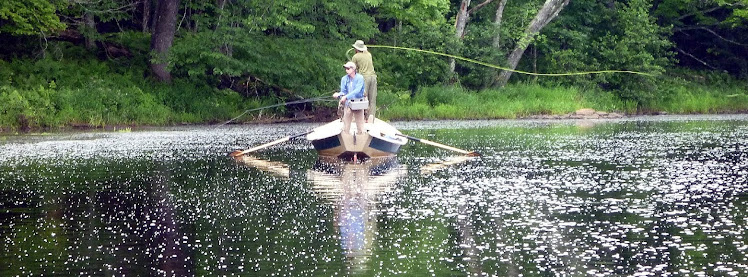Iowa DNR staff and Hawkeye Fly Fishing Association members teamed up on Saturday, April 26, 2014, to
conduct a fish survey on Iowa’s Spring Branch Creek, located in Delaware
County. A hog of an Iowa brown trout, 21.5" in length, was netted, its length and weight
recorded, & it was then released. Many
browns, rainbows, brook trout, and other fish species were collected along ~.33
miles of stream via electrofishing, the required data was recorded, & the
fish were safely released.
 Tools
used for the day’s fish survey included a backpack electrofisher, nets,
buckets, measuring board, scale, and a PIT tag reader. On July 3, 2013, one hundred brown trout in
this particular stream were implanted with PIT (Passive Integrated Transponder)
tags in the abdominal cavity. The small,
long-lasting tags allow fish to be individually identified. During this year’s April survey, 27 of the
107 brown trout captured contained the previously-implanted PIT tags. Mr. Kirby reported, “This is a high rate of
return for fish left at large in an open stream system for an extended period
of time.”
Tools
used for the day’s fish survey included a backpack electrofisher, nets,
buckets, measuring board, scale, and a PIT tag reader. On July 3, 2013, one hundred brown trout in
this particular stream were implanted with PIT (Passive Integrated Transponder)
tags in the abdominal cavity. The small,
long-lasting tags allow fish to be individually identified. During this year’s April survey, 27 of the
107 brown trout captured contained the previously-implanted PIT tags. Mr. Kirby reported, “This is a high rate of
return for fish left at large in an open stream system for an extended period
of time.”  During this year’s survey, 7 species of fish
were collected (brown trout = 107; creek chub = 26; white sucker = 13; brook
trout = 4; sculpin sp. = 3; rainbow trout = 1; brook stickleback = 1). Mr. Kirby indicated this was a fairly low
number of species for an Iowa stream. However, he added that this was not surprising
for an Iowa coldwater stream because brown trout are excellent predators & the stream for this region contains a moderately high density of brown trout.
During this year’s survey, 7 species of fish
were collected (brown trout = 107; creek chub = 26; white sucker = 13; brook
trout = 4; sculpin sp. = 3; rainbow trout = 1; brook stickleback = 1). Mr. Kirby indicated this was a fairly low
number of species for an Iowa stream. However, he added that this was not surprising
for an Iowa coldwater stream because brown trout are excellent predators & the stream for this region contains a moderately high density of brown trout.Approximately 16 HFFA members, representing the 4 branches of the club, and DNR staff Dan Kirby and Mark Winn, participated in the workday. Following the survey, workers were invited to a cook-out, which was provided in traditional fashion by the Mullins family and their ‘chuck wagon’, with food donated by the HFFA. An HFFA board member meeting followed but a few lucky members elected to 'survey' another section of the stream – this time with fly rods in hand.
I asked Mr. Kirby if he would provide readers
with current, general information about
Spring Branch Creek. The information provided in his response is a
perfect example of why it is important that the community, whether it be
organizations, businesses or individuals, work with the DNR to help protect and
maintain our natural resources. By
participating in work days, through education about the benefits of good land
use practices, by donating money or volunteering time, or simply by picking up
trash & not littering, we can all make a difference & continue to enjoy
the natural resources we are so lucky to have.
This is Mr. Kirby’s response in its entirety: “The coldwater segment of Spring Branch
(from the upper springs to the Maquoketa River) is about 3 miles long and about
1.4 miles of that length is in public ownership or in a permanent public
angling access easement. Spring Branch
is recognized within Iowa Code as an Outstanding Iowa Water and it certainly
deserves that status. The springs that
supply cold water to Spring Branch are among the highest quality spring sources
in Iowa. These quality waters have long
been recognized—a trout hatchery has been located near Spring Branch since the
1880’s. Temperatures within Spring
Branch will typically fall between 40 degrees and 65 degrees Fahrenheit on a
year round basis, with temperatures outside that range occurring in stream
segments far isolated from the primary spring sources during extremely cold or
hot days.
We discontinued
stocking brown trout into Spring Branch during 2008 and the population seems to
be maintaining good trout density and size structure in the absence of
stocking. We currently stock about 200
advanced fingerling (8-inch) rainbow trout and 200 advanced fingerling brook
trout into Spring Branch. The lower end
of Spring Branch (Baileys Ford Park) receives a stocking of about 12,000
catchable (10 – 12 inch long) rainbow trout and 3,000 catchable brook trout
during a year.
As is the case for all Iowa streams and rivers, water
quality is central to the quality of Spring Branch Creek and the fishery in
Spring Branch. Watershed quality and
land-use will ultimately determine fishery quality in Spring Branch now and in
the future.”























